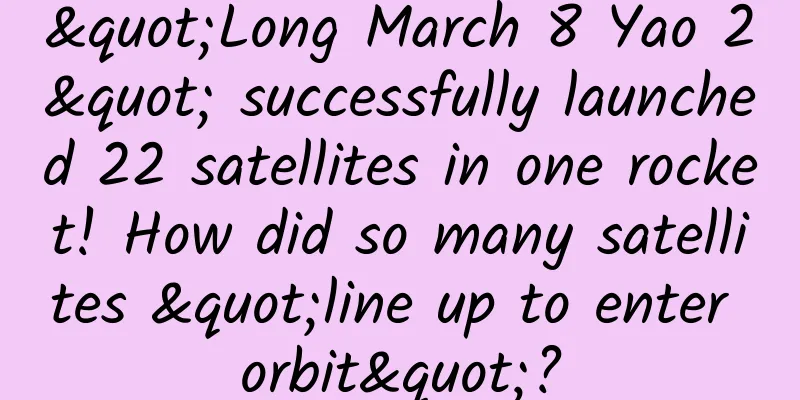"Long March 8 Yao 2" successfully launched 22 satellites in one rocket! How did so many satellites "line up to enter orbit"?

|
On March 5, the Long March 2C rocket successfully launched seven satellites into space. What are the difficulties in launching multiple satellites with one rocket? How can so many satellites be dispersed into orbit? Compiled by New Media Editor Duan Dawei At 14:01 on March 5, the Long March 2C rocket, developed by the China Academy of Launch Vehicle Technology under the China Aerospace Science and Technology Corporation, ignited and launched from the Xichang Satellite Launch Center, successfully sending six Galaxy Space Batch 02 satellites and one Xuanmingxingyuan micro-nano satellite into the predetermined orbit. The launch mission was a complete success. (Photo source: Beijing Daily Client, Photographed by Xiao Guojun) Just recently on the morning of February 27, the Long March 8 Yao 2 carrier rocket ignited and took off from the Wenchang Space Launch Center, successfully sending 22 satellites into the predetermined orbit, setting a new record for my country's multiple satellite launches with one rocket. ▲Long March 8 Yao 2 carrier rocket launch site (Source: China.com) This launch is the maiden flight of the Long March 8's boosterless configuration and also the first launch of my country's new generation of carrier rockets this year. It carries a total of 22 commercial satellites, including Hainan-1 01 and 02, and Dayun Satellite. These satellites will be mainly used for earth observation, low-orbit Internet of Things communications and space science experiments. my country began to explore the "multiple satellites in one rocket" technology very early. The earliest "multiple satellites in one rocket" launch can be traced back to September 20, 1981. On that day, the Storm-1 carrier rocket successfully launched three scientific experimental satellites, Practice-2, Practice-2A, and Practice-2B. Since then, my country has become the fourth country in the world to master the "multiple satellites in one rocket" technology. What are the difficulties in launching multiple satellites in one rocket? How to disperse so many satellites into orbit? What are the advantages of multi-satellite launch? Who holds the world record for multiple satellites in one rocket? ✶ ✶ ✶ What are the difficulties in launching multiple satellites with one rocket? At present, major aviation powers including the United States, Russia and China have mastered the technology of launching multiple satellites with one rocket, but many problems still need to be solved to successfully achieve the launch. Gravity loss is the biggest difficulty faced during launch. In theory, launching a launch vehicle into space at the fastest speed is the most energy-efficient. However, since the Earth is a celestial body with a very strong gravitational force, if the rocket is not fast enough, gravity will cause huge energy loss and waste a lot of propellant. On the other hand, the earth has a dense atmosphere. If the rocket is too fast, atmospheric drag will also consume some energy. At the same time, the atmosphere will also cause many interferences to the rocket. The liquid fuel used in the rocket engine will vibrate during the combustion in the combustion chamber and the ejection from the nozzle. In addition, the rocket will also vibrate during the high-speed passage through the atmosphere. Eventually, these violent vibrations will be transmitted to the payload, that is, the satellite. ▲The Long March 8 Yao 2 rocket ready for launch. (Photo source: China Academy of Launch Vehicle Technology) The multi-satellite launch technology requires the adapter on the top of the rocket to be larger to accommodate more satellites; at the same time, it requires it to be lighter to save energy, leaving the carrying capacity to the payload and effectively exerting the benefits of the launch vehicle. Therefore, compared with launching one satellite per rocket, launching multiple satellites per rocket brings more complex vibration conditions, requiring researchers to perform complex and precise mathematical calculations to ensure that the satellites installed in various parts of the launch vehicle can withstand vibration. In addition to mechanical problems, the satellite also needs to undergo a number of tests during the ground development phase, such as thermal vacuum tests, to eliminate technical safety risks. ✶ ✶ ✶ How are satellites dispersed into orbit? Satellite separation is divided into two categories: sending satellites into the same orbit and sending them into different orbits. ▲The Falcon-9 rocket launches 64 small microsatellites into low Earth orbit (Photo source: China News Service) Orbital insertion accuracy and time interval are the key to achieving multiple satellite separation and entering different orbits. The launch vehicle must first have attitude control and orbit change capabilities. After the launch vehicle enters the target orbit, it cannot release the payload immediately, but needs to release it in sequence with a time interval. At the same time, the last stage of the launch vehicle is also required to adjust its attitude when it reaches the orbit, so that the release of a certain payload is in line with its predetermined direction. Due to the large amount of payload, the release time interval is extended accordingly to ensure that satellite collisions are avoided, so the launch vehicle needs to have a certain power supply capacity. Currently, most satellites use solar panels, which have sustainable power supply capabilities. However, launch vehicles usually use batteries, which cannot provide power continuously. Before actual operation, researchers on the ground must perform detailed numerical calculations and mathematical simulations to simulate the process of releasing payloads in sequence after the rocket enters orbit, to ensure reliable and safe satellite release. ✶ ✶ ✶ What are the advantages of multi-satellite launch? Yang Yuguang, a researcher at the Second Academy of China Aerospace Science and Industry Corporation and vice chairman of the Space Transportation Committee of the International Astronautical Federation, said that the technology of launching multiple satellites with one rocket has become relatively mature worldwide, and major space powers including the United States, Russia and China have mastered this technology relatively well. At present, the micro-satellite industry is developing rapidly. For such satellites, using a separate small launch vehicle to launch is more flexible and can quickly meet the launch requirements, but the cost is relatively high. The launch vehicle's own control system, power system, and structural system account for a lot of weight. The larger the rocket, the lower the proportion of these systems, that is, the lower the unit cost per kilogram of the rocket's payload. Generally speaking, using a large rocket for launch has lower launch costs. The rapid development of small satellites combined with the lower transportation costs of large rockets has led to a trend of "group-order" launches. Yang Yuguang believes that my country's launch vehicles will become more commercially mature in the future. In addition to more reliable technology, good commercial operations will further reduce launch costs and improve the competitiveness of my country's multi-satellite launch technology. ✶ ✶ ✶ Who holds the world record for “multiple satellites launched with one rocket”? On January 24, 2021, SpaceX completed the launch of the Transporter 1. The Falcon 9 rocket carried 143 satellites into space, setting a new record for the number of satellites launched in a single launch. This broke the record of "104 satellites in one launch" set by an Indian company in 2017. ▲The "143 stars in one launch" mission is a new milestone for SpaceX's Falcon 9 reusable rocket (Photo source: Xinhuanet) The success of launching 143 satellites in one rocket means that "rocket express delivery" has finally become a reality. At present, the US "Space Technology Exploration" company has made new breakthroughs in the commercial operation of rockets. The company stipulates that the charge for satellites within 200 kilograms is US$100, and the excess is only US$5,000 per kilogram. This shows that the company has matured in the commercial operation of rockets. In the future, if any individual or company needs it, they can send items into space. (Information compiled from: China National Radio, Xinhuanet, The Paper, China News Network, China Academy of Launch Vehicle Technology, etc.) Produced by: Science Central Kitchen Produced by: Beijing Science and Technology News | Beijing Science and Technology Media Welcome to share to your circle of friends Reproduction without authorization is prohibited |
<<: Until the day before his death, he was still writing in his diary...
>>: What is it like to fall into a black hole?
Recommend
Things about the first releases on the three major channels of BAT, see how the three major first releases are completed in one go!
For small and medium-sized companies, the first r...
They say: A girl weighing 90 catties is fat, and a boy who is 1.78 meters tall is short
appendix: 1. A little-known fact about body shape...
From 0 to 1 entry-level e-commerce store operation plan
Many friends who do e-commerce often come to cons...
Dialogue with Xie Xiaohu, former global R&D director of Google: Put aside more "should" and "best" when making important choices
In the fall of 2003, Tiger Xie, a computer scienc...
From ad images to landing pages, 14 tips to improve conversions
This article is a summary of the book "The B...
Tesla Model Y, BYD Tang EV and Arcfox Alpha T: Which pure electric long-range SUV is better?
Looking at the new energy vehicle companies estab...
What happened with Meituan’s response to the cancellation of Alipay payment? Why did Meituan cancel Alipay payment?
What happened with Meituan’s response to the canc...
World Book Day | Middle school students talk to academicians, writers, aerospace experts... to solve the "confusion" of reading
General Secretary Xi Jinping sent a congratulator...
The Sexy and Skinny of Operator TVs from Damai TV
Nowadays, the word "disruption" has bec...
What methods do internet celebrities like Papi Jiang use for live streaming?
Live streaming has gradually evolved from an earl...
Why do products searched on JD.com appear in Douyin ads?
I often hear friends around me say: WC, Toutiao w...
Learn about the Longevity Knowledge Report: Live Longer and Better
The World Economic Forum has released a new repor...
3 days, 0 budget, sales of 10,000 goods, all the activity methodology is here!
The article combines the author's actual expe...
Huawei's creation of Hongmeng should not be praised in a flattering way
Recently, Huawei's Hongmeng system has become...
Quantum teleportation energy: Is extracting energy from a vacuum a reality?
It's like science fiction, the vacuum energy ...









